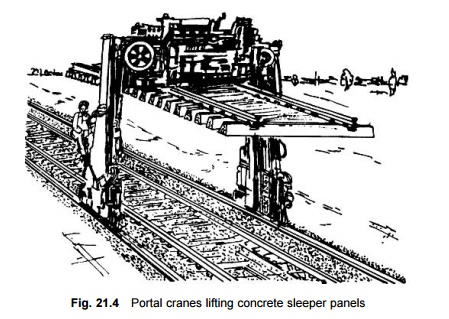Chapter: Civil : Railway Airport Harbour Engineering : Railway Engineering : Rehabilitation and Renewal of Track
Renewal of Rail Track: Mechanized Re-laying
Mechanized Re-laying
A concrete sleeper weighs more
than 200 kg and, therefore, unlike wooden or metal sleepers, cannot be handled
easily by manual labour. Apart from being heavy, a concrete sleeper is brittle
in nature and is likely to get damaged if dropped from some height or handled
roughly. Furthermore, the conventional method of re-laying, which employs manual
labour, is quite slow and the quality of the work done is also not very good.
The need for mechanized re-laying
has been increasingly felt on account of these limitations, particularly in
view of the large-scale use of concrete sleepers on Indian Railways.
Mechanical
re-laying can be done by either one of the following methods.
(a) Semi-mechanized
re-laying using prefabricated panels, in which the main work of re-laying is
done mechanically with the help of PQRS (Plesser quick relaying system) equipment
but all other minor works are done manually.
(b) Fully
mechanized re-laying with the help of track re-laying trains.
Mechanical Re-laying using Pre-fabricated
Panels
On Indian Railways, mechanical re-laying is mostly done with
the help of PQRS equipment. This equipment is manufactured by an Austrian firm
Messrs Plasser and Theurer in a factory near Faridabad, India. The equipment
basically consists of two self-propelled portal cranes, each capable of lifting
5 to 9 t. The portal cranes run on an auxiliary track with a 3.4-m gauge. Track
panels consisting of concrete sleepers, rails, and fittings are prefabricated
in the base workshop and used for re-laying the track. These prefabricated
panels are loaded in special BFR-type wagons and taken to the work site along
with portal cranes, etc. [BFR is a classification scheme for freight wagons on
IR. B indicates bogie wagon, F indicates flat car, and R indicates rapid (forced)
discharge]. The old track is dismantled and new panels are laid with the help
of portal cranes. A fully equipped train called the PQRS rake that consists of
the following parts is then taken to the site of work.
(a) Engine
(b) Coal
wagon (for recoupment of coal in the engine)
(c) Crew rest
van (for the staff to stay and rest in)
(d) Guard
compartment (for controlling the movement of the train)
(e) Mobile
workshop-cum-rest van (for urgent repairs to be done at the site)
(f) Special
wagon called BFR loaded with two portal cranes
(g) Two empty
BFRs for loading released panels
Semi-mechanized track renewal
work is then carried out in the following sequence.
1. The
auxiliary track with a 3.4-m gauge is first laid at the location where
re-laying is to be done. The rails of the existing track are also replaced with
13-m service rails.
2. A fully
equipped train comprising of the various components and loaded with prefabricated
panels is taken to the work site after setting up a traffic block, and also a
power block in the case of an electrified section.
3. The
portal cranes are then unloaded mechanically on the auxiliary track of a 3.4-m
gauge.
4. The
portal cranes are utilized to dismantle the two panels of the existing track
and load them onto empty BFRs.
5. The
ballast bed is prepared manually and levelled up to a predetermined point.
6. On the
return trip, the portal cranes are utilized to lift the pre-assembled panels of
concrete sleepers from the BFRs and lay them on the levelled ballast bed.
The procedure is repeated so that in the forward trip, the
portal cranes lift the dismantled panels and place them in empty BFRs, and on
the return trip, the portal cranes lift the two pre-assembled panels from the
loaded BFRs and lay them on the prepared bed (see Fig. 21.4).

The new panels are then connected
using fish plates, fittings, and fastenings. This method of re-laying is quick
and independent and is best suited to Indian conditions. It is possible to
achieve an average output of about 200 m per effective hour of working. About
0.8 km of re-laying can be accomplished in a 4-hr block.
Related Topics